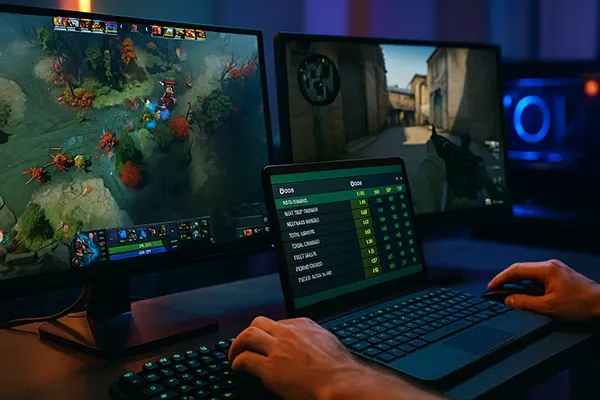
Live Betting on Esports: Dota 2 and CS2 in Real-Time
Live betting on esports has become a defining feature of modern wagering culture, particularly within competitive titles such as Dota 2 and Counter-Strike 2 (CS2). These games offer dynamic environments that shift rapidly, presenting both unique opportunities and significant risks for bettors. Understanding how live betting works, the specifics of each game, and the influence of real-time events is essential for making informed decisions in this fast-paced arena.
The Core Mechanics of Live Esports Betting
Live esports betting involves placing wagers while the match is in progress. Unlike pre-match bets, live bets respond to in-game developments such as team performance, player eliminations, and sudden comebacks. The betting odds are adjusted continuously by algorithms based on real-time statistics and predictive models.
One of the key challenges in live betting is timing. The speed at which markets are suspended and reopened makes it crucial for bettors to be both observant and decisive. Small moments, like a successful Roshan kill in Dota 2 or a clutch round win in CS2, can shift the betting landscape drastically.
Technological infrastructure also plays a critical role. Fast data feeds, latency minimisation, and synchronisation with official broadcasts ensure that odds remain relevant and that users can react swiftly. Betting sites now integrate dedicated esports modules to manage this demand.
Risk Factors in Live Wagering
Live betting naturally carries a higher volatility due to the unpredictable nature of esports. Sudden disconnections, surprise tactics, or unexpected player substitutions can drastically affect outcomes. Unlike traditional sports, where momentum changes are more gradual, esports matches can flip within seconds.
Moreover, the speed at which odds change can lead to rushed decisions. Many bettors, particularly those unfamiliar with the pace of CS2 or Dota 2, may chase opportunities without fully assessing the risk. Effective bankroll management becomes crucial in this context.
It is also important to consider the psychological pressure of live betting. Rapid decision-making can increase emotional betting, which often leads to losses. Tools such as bet limits and self-exclusion can help mitigate these effects and encourage responsible behaviour.
Live Betting in Dota 2: Complexity and Depth
Dota 2 is known for its strategic depth and long match durations, often exceeding 40 minutes. Live betting in Dota 2 typically includes markets such as First Blood, Next Roshan Kill, Total Towers Destroyed, and Map Winner. Each of these elements reflects in-game developments that can be observed in real-time.
The draft phase plays a critical role in shaping the match’s direction. Observing hero picks and bans can provide early insight into a team’s game plan, influencing early live markets. Additionally, power spikes and item timings often determine mid-game momentum swings.
Experienced bettors frequently analyse hero compositions and laning outcomes within the first ten minutes. If a core hero is shut down early or gains a significant gold advantage, it can be a strong signal for the rest of the game’s trajectory. Such elements make Dota 2 both exciting and challenging for live bettors.
Impact of Patch Updates and Meta
Frequent patch updates can redefine the game’s meta overnight, altering hero viability, item builds, and overall strategies. Bettors who fail to keep up with changes risk misinterpreting live-game scenarios and backing suboptimal outcomes.
For example, if a hero recently received a nerf but is still picked due to habit or misunderstanding, its underperformance could influence the result drastically. Conversely, newly buffed heroes may surprise opponents and swing engagements in favour of a less favoured team.
Professional Dota 2 bettors often rely on patch notes and scrim results to anticipate how teams adapt. Such research allows for better contextual understanding of live matches and increases the accuracy of real-time predictions.

Live Betting in Counter-Strike 2: Speed and Precision
CS2 presents a different betting environment compared to Dota 2. Rounds are shorter, with clear win conditions, making the game suitable for frequent live betting. Markets like Round Winner, Total Rounds Played, First Kill in Round, and Pistol Round Winner are popular during CS2 events.
Key moments such as economy resets, successful bomb plants, or consecutive eco rounds offer windows for informed bets. Observing team communication and coordination during these rounds is vital. A team with better utility usage and site execution will likely perform more consistently.
Live betting on CS2 requires understanding of map-specific strategies. For instance, Inferno and Mirage have different pacing and CT/T-side dynamics, influencing betting decisions in real time. Bettors must consider these nuances before placing mid-match wagers.
Influence of Player Form and Substitutes
Player performance in CS2 can vary widely across matches and maps. A star AWPer might dominate one series and underperform in the next due to fatigue or mental pressure. Live betting allows users to capitalise on such shifts in real time, especially when a team relies heavily on individual skill.
In addition, last-minute roster changes or the presence of stand-ins can significantly affect a team’s synergy and communication. Bettors must verify official line-ups before placing wagers and monitor how substitutions affect round outcomes.
Professional analysts recommend tracking player statistics and recent match histories to build a reliable foundation for live betting. Trends such as aggressive entry fragging or passive anchor playstyles are crucial to predicting in-round behaviour and potential market swings.
